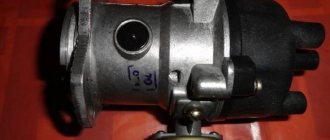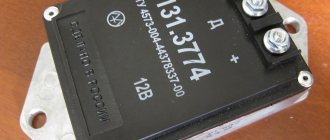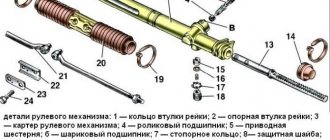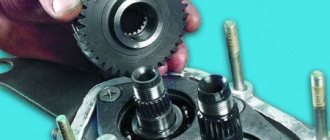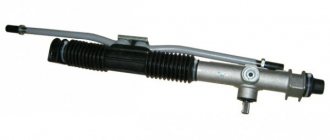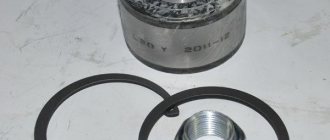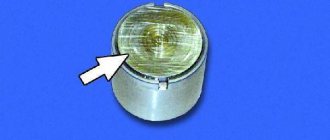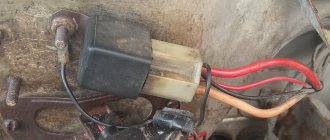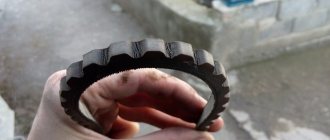The starter of the VAZ 2108 car is the most frequently broken part. Therefore, it is important to be able to repair and replace it yourself, without resorting to the services of car services, it will be much cheaper. This simple step is easy to do by following the detailed instructions.
The main task of the starter is to convert mechanical energy into electrical energy in sufficient quantity to start the engine.
A few seconds are enough to start the starter if the battery is well charged.
Starter VAZ 2108
Long-term operation of the starter is contraindicated, but car enthusiasts do this a lot, especially in low temperatures in winter. This use is one of the most common causes of VAZ 2108 starter failure.
The most common breakdowns are:
- The relay does not work and the armature does not turn;
- Low armature rotation speed;
- The crankshaft does not rotate;
- The starter continues to operate even though the engine has already started.
All these problems require repair. To carry out repair work, you will need to remove, check and disassemble the starter of the VAZ 2108.
Starter VAZ 2108, 2109, 21099: checking, removal and disassembly
A starter is a device without which it is impossible to start a car engine. That is why it is necessary to be attentive to absolutely any nuances in its functioning. If you encounter any of these situations:
- the starter generally does not respond to turning the ignition key;
- the starter functions, but at idle, when turning the key in the ignition switch, the bendix does not engage;
- the starter turns, but extremely slowly, the reason may be a discharged battery, but if after fully charging it there is no improvement, then the problem is in the starter itself.
- It is definitely necessary to check the starter device for damage.
How to check the starter of VAZ 2108, 21099, 2109?
If the solenoid relay fails, the starter will work when it is closed with something metal, such as a screwdriver or wrench. Let's take a closer look at how to close the starter of the VAZ 2108, 21099, 2109:
- Place the gearbox in neutral, tighten the handbrake all the way, insert the key into the ignition, turn it in the desired direction.
- Next, close the two large terminals that are located on the starter. The wrench and screwdriver should work in place of a possibly faulty solenoid relay.
- Bendix will turn the crankshaft and as a result the engine will start, provided that no other element of the starter has failed.
Be sure to note that the switch in contactless ignition systems controls the voltage supplied to the coil, but in older contact systems there is no such control, so if the starter closes, the coil could potentially break.
If, after closing the starter, it turns out that the problem is not in the solenoid relay, continue the diagnosis:
- Make sure the battery terminals are not oxidized; if necessary, clean them with a knife or screwdriver or sandpaper.
- Ring the wires connected to the starter with a tester, check all connections, if necessary, tighten the connection nuts and strengthen weak contacts.
- Check to see if the cause of the breakdown lies in the ignition switch. Clean the contacts going to it. Disconnect them one by one, so you don’t confuse anything.
We looked at all the main ways to check the VAZ 2108, 2109, 21099 starter without dismantling it. If the cause of the breakdown has not been identified, then it is necessary to remove it from the car and check it more carefully.
How to remove and disassemble the VAZ 2108, 2109, 21099 starter?
Before starting dismantling work, be sure to disconnect the negative terminal from the battery so that there is no short circuit!
After completing this action, proceed to removing the VAZ 2109, 21099, 2108 starter:
After dismantling is completed, the question arises: how to disassemble the VAZ 2108, 2109, 21099 starter? Disassembly begins with the fact that you will need to carefully knock down the locking and restrictive ring, and then unscrew the fasteners of the back cover and remove it. Now you have reached the graphite brushes, stator and armature. It should be noted that there may not be a gearbox in this part, in which case the stator is taken out after the armature. If the design does include this element, then you need to act a little differently: pull out the stator first, then the armature, and lastly, pull out the gearbox.
Be careful, disassembly is often complicated by the loss of an adjusting washer installed on the armature axis, or the loss of other small parts, and the absence of even one of them calls into question the further operation of the entire mechanism!
Choosing a new starter for VAZ 2108, 2109, 21099 cars
If you have come to the conclusion that repairing the starter device is impractical, then the question arises, which starter to buy for the VAZ 2108? In the case of VAZ cars, the choice is possible between conventional starters and gearbox ones. To be convinced of the significant advantages of the latter, let’s consider the principle of their operation.
In a standard starter, the force is directly transmitted to the flywheel from the armature. At the same time, the retractor relay is activated, pushing the bendix forward, which helps it engage with the flywheel teeth. A gear starter is characterized by a similar operating principle, but there is a significant difference in force transmission. It uses a gearbox, which allows you to reduce the power of the electric motor. In addition, an important feature of this type of starter is the presence of permanent magnets in the windings, which make the operation of the electric motor more reliable.
The energy consumption of a gear starter is significantly less, which is due to the presence of an additional mechanism that increases the torque of the electric motor. By the way, this is also due to the compact dimensions of such a starter device. In addition, the gear starter operates quietly even with a slightly low battery, which a conventional starter is not capable of.
At low temperatures in winter, the operation of a gear starter is also more reliable. It can even crank through slightly thickened oil, which a conventional starter cannot do. This becomes possible thanks to the gearbox.
If, taking into account all the advantages, you have made your choice in favor of the VAZ 2108 gear starter, then we offer you high-quality devices from the Belarusian. They have a two-year warranty, and spare parts are always available.
Why does starter 2108 often break?
The starter is a short-term motor. When it is in good condition and the battery produces high-quality current, starting the device lasts a few seconds. It cannot function for a long time, so drivers who like to “drive” the starter need to give up this habit and use it only as the manufacturers advise.
As practice shows, repair and replacement of the starter on a VAZ 2108 is often required in cases where the car owner heavily overloads it or starts it with a weak battery. In addition, failure of the starter may be associated with one or other problems that are caused by malfunctions of the vehicle’s power unit.
Disassembling the starter for VAZ 2108, 2109, 21099 cars
To carry out repairs, maintenance or replacement of parts, the starter must be removed from the engine and disassembled. Let's see how to do this quickly - without wasting extra time and effort, using the example of disassembling starter 29.3708, which is widely used on VAZ 2108, 2109, 21099 cars.
Required Tools
— Slotted screwdriver (phillips)
— Wrenches (open-end or socket) for 10, 13 and 17 mm
— Retaining ring puller (optional)
Preparatory work
— Remove the starter from the car engine
The procedure for disassembling the starter 29.3708
Remove the traction (retractor) relay
To do this, use a 13 mm wrench to unscrew the nut securing the tip of the starter winding output, and disconnect the tip from the contact bolt of the traction relay. Using a slotted screwdriver (screws for a Phillips screwdriver or a 10 mm wrench can also be used), unscrew the three screws securing the relay and disconnect it from the starter housing.
Remove the starter traction (retractor) relay
At the same time, we remove the relay core earring from engagement with the tip of the drive lever (Bendix).
Remove the solenoid relay core
Remove the protective cover of the starter brush assembly
To do this, use a slotted (Phillips) screwdriver to unscrew the two screws securing it.
Removing the starter rear protective cover
Disconnect the cover from the starter housing. Underneath there is a rubber ring-gasket.
Remove the sealing ring of the protective cover
We remove the axis of the starter drive lever (Bendix)
To do this, use pliers to squeeze the whiskers of its latch and use them to remove the latch from the hole on the axle. We knock the axle out of the hole in the starter housing. To knock out the axle, you can use a nail of a suitable diameter and a hammer.
We remove the bendix axis (starter drive)
Remove the Bendix travel limiter ring
We knock it down with light blows of a hammer (you can use a 17 mm open-end wrench).
We knock down the bendix limit ring
We remove the retaining ring located under it with a puller or simply pry it off with a slotted screwdriver.
Remove the bendix travel limiter retaining ring
Unscrew the two long screws holding the two halves of the starter housing together.
To do this, you need a 10 mm wrench. We take out the bolts and separate the halves. If they do not separate, lightly hit the front half with a hammer.
Unscrew the starter housing pinch bolts
Removing the starter drive (Bendix)
Remove the rubber plug from the slot in the front of the starter housing. Using a screwdriver, disconnect the legs of the drive lever from the protrusions on the drive itself.
Removing the starter drive ("Bendix")
We push the bendix forward and take it out.
Drive parts ("Bendix")
Disconnect the armature and starter housing
To do this, pry it up with a screwdriver and remove the locking half-ring on the armature shank. We also remove the washer located under it.
Remove the armature shaft retaining ring
If it is necessary to remove the stator windings, unscrew the screws securing them to the starter housing.
Remove the armature and starter stator windings
Removing the brushes
If it is necessary to remove the brushes, unscrew the screws securing them and remove them.
Removing the starter brushes
Do-it-yourself repair and disassembly of the starter on a VAZ 2107
Yesterday I decided to completely disassemble my used starter in order to show with a clear example how to disassemble it and subsequent repair of the device. I will also describe the solenoid relay, which is often the cause of the starter itself not working. Perhaps this is where we should start.
Cleaning nickels from carbon deposits on the solenoid relay
All this is best done on a removed part, which you can read about here. After this, you need to use a deep socket and a wrench to unscrew the three nuts securing the cover to the body, as is clearly shown in the photo below:
When all the nuts are unscrewed, you need to press on all the bolts from the same side and pull them out from the back:
Now carefully fold back the relay cover, but not all the way, as the wire will get in the way:
Pay attention to the central copper plate: it will definitely need to be cleaned of plaque and carbon deposits, if any. Also, you need to unscrew the nickels themselves (two in total) by unscrewing the two nuts on the outside of the cover:
And then you can take them out from there with your hands, from the back side:
Also clean them thoroughly with fine sandpaper until shiny:
After completing this simple procedure, you can put everything back in place in the reverse order. If the problem was precisely the burnt nickels, then it will definitely disappear!
How to replace starter brushes on a VAZ 2107
The brushes on the starter can also wear out and cause unit failure. In this case, they need to be replaced. On cars of the “classic” family, starters are slightly different from each other. But there won't be much difference in replacing the brushes. It will be necessary to either remove the back cover under which they are located, after unscrewing a couple of bolts. Or unscrew just one bolt, which tightens the protective bracket, under which the brushes are located:
And this is what it looks like after:
There are a total of 4 brushes here, each of which can be removed through a separate window. You just need to unscrew one bolt securing it:
And then, squeezing the spring clip, pry it off with a screwdriver, and it can be easily removed:
All the others are removed in exactly the same way, and they all need to be changed at once. Installation is carried out in reverse order.
Disassembling the VAZ 2107 starter and replacing the main components
In order to disassemble the starter, we need the following tool:
- Socket head for 10
- Ratchet or crank
- Impact or power screwdriver
- Flat screwdriver
- Hammer
- Key for power screwdriver (in my case 19)
First, unscrew the two nuts with a 10mm wrench, which are shown below:
Then remove the cover, prying it with a screwdriver if necessary:
After this, you can remove the housing along with the winding from the studs:
If it is necessary to replace the winding, then this is where we need a power screwdriver. It is necessary to unscrew the 4 bolts on the body on each side, as shown below:
After which the plates pressing the winding fall, and it can be safely removed:
Since the part with the anchor is free, we can begin to dismantle it. To do this, use a thin screwdriver to pry up the plastic bracket; in the photo below it is shown after the shift:
And remove the anchor from the front cover of the starter housing:
And to remove the coupling with the shaft, you must again remove the retaining ring with a screwdriver:
And after that it’s easy to remove it from the rotor shaft:
If it is necessary to repair or replace certain parts, we buy new ones and install them in the reverse order.
Determining the cause of the malfunction
Do not rush to completely disassemble the VAZ 2109 starter; as always, it is first important to correctly identify the fault. Therefore, you should start by checking:
We disconnect the wiring from the terminal and connect it to the “plus” directly. If the engine is running, this means that the power relay is faulty. If the motor is silent, then the likely reason is wear of the brushes. A simple method will help you identify misalignment or wear of the brushes. Remove the unit from the machine, and we check it, start it, removed from the car. When we check the starter separately from the car, you should pay attention to the functioning of its engine. It often happens that the engine works perfectly in only one position. You just need to turn it to one side, and the contact will immediately disappear. Such a strange phenomenon is easy understandable: When the brushes of the starter have a normal length, they are pressed tightly, by means of the springs of the brush holder. When the brushes wear out heavily, the force of the springs may not be enough, then the brush is pressed only by its own weight. Therefore, when the position of the unit changes, the contact disappears. A similar phenomenon is observed when the brushes “hang”, having a normal length, or when the brushes are skewed
Replacing brushes
Replacing starter brushes on a VAZ 2109 is a simple procedure. Any novice auto mechanic or car enthusiast can replace brushes on their own
All you need to do is follow simple steps to complete this task:
- We take the unit removed from the car
- From the starter terminal, disconnect the cable, remove the screws connecting the shaft and commutator covers
- Remove the sealing ring, cover, gasket, then the ring clamp and the second sealing ring located behind it
After unscrewing the screws, remove the cover, gasket, clamp and all o-rings
After this, we proceed to removing the rear cover of the starter by unscrewing the nuts from the tie rods
Remove the nuts from the tie rods
Removing the brush holder assembly
We take out the brush holder assembly
- After this, the brushes will fall out under the action of springs, but will be held in place by wires
- After disassembly, we proceed to inspection and, if necessary, replacement of brushes
- When disassembling the starter, do not forget to carefully arrange the parts in the sequence of their removal, so as not to get confused during assembly.
- The appearance of “extra” parts means that you forgot to screw something on
- We inspect and, if necessary, replace the VAZ 2109 starter brushes or the entire assembly
- Before assembling, we carry out its maintenance - we clean all its elements
- We place the brush plates on the commutator, center them, and then put on the springs and brush holders
- We install the brush holder assembly on the commutator armature, and insert the sealing sleeve into the cutout on the body
- We put the manifold cover on the armature, then the o-ring with gaskets
- After this, install the gaskets, o-ring, ring clamp, put the shaft cover on the manifold cover, tighten the bolts
- Connect the power cable to the electromagnetic starter and tighten the nut
- All that remains is to screw the unit to the engine and connect the wires to it
Now replacing the VAZ 2109 starter brush is a breeze for you, you are convinced that the operation is simple and accessible to everyone, in addition you can always watch a training video.
DIY Bendix starter repair
Repairing a starter is a troublesome task, but by doing it yourself, you can save your family budget. During operation, the starter constantly experiences heavy loads and is exposed to dust, moisture, dirt and oil, which contributes to the rapid destruction of the electric motor insulation and breakdown of the drive mechanism.
We have already written about some signs of a faulty starter and about checking and repairing the solenoid relay. Another malfunction that leads to repair of the starter is slipping of the freewheel - Bendix, which occurs as a result of contamination of the grooves and rollers. In this case, when the starter is turned on, the noise of a rotating armature is heard, and the crankshaft stands still (this is well shown in the video instructions for repairing the starter at the bottom of the page). There is no way around this without renovations.
Checking the Bendix and repairing it without disassembling the starter
You can check the bendix directly on the car without removing the entire unit. To do this you need:
- Enable transmission;
- Depress the brake pedal;
- Start the starter.
If at the same time you hear the sound of armature rotation, then the bendix is slipping and needs to be repaired or replaced with a new one.
To begin with, you can try to carry out minor repairs and remove dirt from the Bendix without disassembling the starter. For this:
- remove the starter from the car ( video instructions at the end of the article);
- immerse it entirely in a container of gasoline and leave it there for several hours;
- Without removing the starter from the container, rotate the clutch gear several times to better flush the grooves;
- remove and dry the starter.
If, as a result of such a “not tricky” repair, the malfunction is not eliminated, you will have to remove and disassemble the overrunning clutch.
Disassembling and reassembling the Bendix when repairing the starter
Repairing the starter with disassembling the bendix is performed in the following order:
- Before disassembling the bendix, first of all, it must be removed from the anchor ( see the video below).
- Then very carefully flare the curved edge of the casing and remove it from the outer race.
- After this, remove the springs and stretch them so that when free they increase by about 10 mm.
- Next, you need to wash all the Bendix parts, the grooves of the outer race in gasoline and clean out the nicks and burrs on the working surfaces.
- Do not forget to lubricate all structural elements with engine oil before assembly.
If you properly roll the edges of the casing, then such a starter repair will extend the life of the Bendix for several more years.
Video instructions for repairing the starter - restoring the Bendix on a VAZ-2109 car
Why contacts burn, how to fix it
It is impossible to avoid burning contacts when operating a car, since a large current constantly passes through the power circuits. Accordingly, there is only one way out - to repair the relay according to the diagram below, clean the contacts, thereby restoring the functionality of the starter.
DIY VAZ 2114 starter repair
The most powerful electrical consumer is the VAZ 2114 starter on the car. The load on the rotor is very large - the electromotive force has to overcome the resistance caused by compression in the engine. And if the starter is in poor technical condition, there is a short circuit in it, the current consumption increases. And the maximum is approximately 600-800 A (when the rotor is jammed).
- What usually goes wrong?
- Removing the starter
- Do-it-yourself disassembly and repair
What usually goes wrong?
On a VAZ 2114 car, you can repair the starter with your own hands in an hour, no more. Provided that all components are replaced with new ones. Most often, starter brushes fail; they rub against the lamellas and wear out. As a result, the rotor does not move when voltage is applied to it. Sometimes even when you turn the ignition key, sparks appear. On new injection cars, which include the VAZ 2114, a gear starter is installed. Its advantage is that its rotor rotates at a higher speed, which makes starting the engine easier.
Its disassembly is practically no different from the procedures that are carried out with a conventional starter. Another typical failure is the destruction of bronze bushings. On a VAZ 2114 car they are located:
- One is in the rear starter cover; partial disassembly will be required to replace it.
- The second is in the engine block. It will have to be replaced through a small window in the clutch housing.
If the bushing breaks, then there is no power to the motor armature. The minus voltage is not transmitted from the battery, or the voltage decreases due to resistance. The result is that the rotor rotates much more slowly, and from the outside it may seem as if the battery is dead. These symptoms are typical not only for VAZ cars, but also for cars of other series and even brands - UAZ, Chevrolet, etc.
Checking the starter using the battery
Before contacting a car service center, buying a new unit or spare parts for it, you should try to check its performance yourself. With the right approach, it is possible to independently identify problems.
First of all, if you suspect a malfunction of the starting device, you need to check the contacts on the battery and starter terminals, their tightness and the presence of oxidation, the battery charge, since in many cases the problem in starting the internal combustion engine is the above factors.
A simple way to check that the electrical network is working is to close the terminal bolts of the electric motor with a screwdriver; before this procedure, you need to put the car in neutral speed (or move the selector lever to park or neutral mode).
If the starter starts the engine, you should look for a fault in the electrical circuit. Otherwise, remove the unit by disconnecting all fasteners from the engine and removing terminals and other wires.
How to check Bendix
After removing the electric motor, it is necessary to inspect the bendix (the gear at the very end); if there is increased wear of the teeth or cracks in it, it should be replaced.
The Bendix should only turn in one direction, otherwise it will have to be replaced. By connecting the unit to the battery, it is unlikely to be able to diagnose the serviceability of the Bendix, since it can spin, but with insufficient force to start the internal combustion engine.
How to check Solenoid relay
When you turn the ignition key, you should hear a click, indicating that the armature is retracted and the bendix is engaged.
Before checking the serviceability of the starter, it is necessary to firmly secure it (either in a vice, having previously wrapped it with a thick layer of fabric, or with the help of a strong assistant who will hold the unit), since a very strong jerk may occur when starting it.
It is necessary to connect the positive from the battery to the positive on the starter, and the negative from the battery to the body of the unit. If the unit is working properly, then there should be a quick and sharp click and the bendix will extend and begin to spin.
If there is no click or movement of the overrunning clutch, it is necessary to replace the solenoid relay. When the power from the battery is disconnected, the bendix should retract.
How to check the Anchor and Brushes
To check the brushes and armature, you will need a multimeter or a 12-volt light bulb. Checking with a light bulb involves connecting its contacts to ground and the brush holder with the starter connected to the battery. When the light comes on, it indicates high brush wear.
When checking with a multimeter, the contacts are connected identically, only the results of measuring the resistance should tend to infinity, otherwise there is a short to ground.
The armature can only be checked by disassembling the electric motor. In addition to carrying out a visual inspection for the presence of oxidation, traces of short circuits, and increased wear, to check the armature you will need a special device PPYA (armature testing device) to check the interturn closure.
The difficulty of diagnosing armature malfunctions, as well as its repair, will require contacting specialized specialists, but in order to avoid unnecessary costs, it is necessary to check all other parts of the unit.
How to check the starter winding
To check the motor winding you will need a multimeter or a light bulb. The wires of the control lamp are connected to the winding terminal and the starter housing. If the light comes on, then there is a breakdown in the winding.
Using the same connection, the winding resistance is checked, for which the multimeter must be switched to the appropriate mode. The average reading of a serviceable winding will be 10 kOhm.
The starter is the most important element of the car, and its malfunction will immediately make itself felt either by the inability to start the car or by difficulties with it.
This unit is very reliable, but problems do occur with it. Some of them are easy to determine on your own, but to identify others you will need special equipment, which is available only to highly specialized specialists.
VAZ 2109 starter - how to assess problems and fix them as well as a mechanic?
For owners of domestic cars, self-repair or assembly of vital mechanisms is familiar and accessible; in this article we will try to improve our skill level and replace the VAZ 2109 starter with our own hands.
Starter circuit and purpose
On all cars, without exception, and therefore on the VAZ 2109, the starter is responsible for starting the engine, or rather, spinning the crankshaft. Essentially, it is a small electric motor. The VAZ 2109 starter device includes a movable rotor, two windings, and a bendix with a set of brushes. How does it all work? Magnetic fields of opposite values are created around the starter and rotor windings, which drives the moving element into dynamics. It is quite easy to apply voltage to the starter, but for the rotor you need an intermediary - brushes consisting of graphite and copper.
What about the Bendix starter of the VAZ 2109, this element transmits movement to the flywheel. The part consists of the following parts: a fork connecting the mechanism to the retractor relay, an overrunning clutch that ensures movement in one direction, and a gear. Many motorists are familiar with the situation when this part is erased. The slipping of the Bendix is clearly audible and indicates that the installation of a new kit is inevitable. And although the cause is often contamination of the mechanism, cleaning it is not recommended. Due to dust and soot, Bendix is subject to wear, often unevenly, and even after washing it will no longer perform its function at the proper level.
There is a gear starter and a simple one. The scheme for transmitting torque to the flywheel is excellent. The gear starter has an additional element between the armature and the bendix. Many consider this design to be more productive and less voracious. True, the gear unit is more difficult to repair.
Starter mechanism malfunctions
If any difficulties arise with starting the car, this unit is the first to be suspected, but now, knowing the design of the VAZ 2109 starter, you will quickly figure out where to look. Various sounds similar to metal grinding should also alert you; it is quite possible that your VAZ 2109 will need to disassemble the starter. The reason may lie in the flywheel, and its crown will need to be replaced. In this case, the car will most likely start, just not right away.
But if the car does not start and there are no alarming sounds, then you may have to replace the clutch. Disassemble the starter and dismantle it, try turning it in both directions. If it rotates freely, then calmly throw away the failed part. You can understand that it is necessary to remove and replace worn starter brushes installed on a VAZ 2109 by a characteristic click, after which the expected engine start will not take place.
Removing and connecting a new starter
In absolutely any of the cases described above, you will be faced with the need to take a closer look at the device. It should be noted that with the release of the VAZ 2109, the question of how to remove the starter became more easily resolved, because in this model the arrangement of components under the hood is much simpler. So, you will need socket and socket wrenches and an inspection hole. Now, regardless of whether it is necessary to replace only the bushings or the entire VAZ 2109 starter, it must be removed. First of all, all the wires of the traction relay are disconnected, after which the block is dismantled. Don't forget to remove the high voltage wire from the battery.
The next step is to dismantle the engine crankcase protection; to do this, simply unscrew the mounting bolts. Then the approach to the mechanism of interest to us is cleared. To remove it, you need to unscrew three nuts - two on the block and one in the engine compartment. The connection diagram for the new VAZ 2109 starter is the same, only it is in the reverse order, so it will not cause any difficulties.
The starter on a VAZ 2109 does not work, what should I do?
The design of starters on the VAZ 2109 has fairly good reliability indicators. But with use and over time, they still fail.
Appearance of the device
Design and operating principle
To understand the features of the repair, you must first study the design of the starter and understand how it works for the benefit of your car.
Let's start with the design. It includes four main nodes.
Knot
Peculiarities
It transmits direct current through four brushes
Freewheel with gear
A clutch or bendix drives the flywheel of your car's engine.
Serves to extend the bendix with gear when turning on the electrical appliance
Ensure easy rotation of the clutch, rotor, and gear. One bushing is located inside the starter, and the second is in the clutch housing.
Device diagram
Having familiarized yourself with the starter diagram, you can discuss the principle of its operation.
Typical faults
It is better to start diagnosing the starter even before you remove it.
After dismantling, some signs of failure, by which the source of the problems can be determined, can no longer be determined.
Signs of a faulty element include:
- An unusual noise occurs when the engine starts;
- Complete absence or slow rotation of the starter;
- Rotation occurs, but there is no gear engagement with the Bendix ring;
- The unit rotates with the bendix, but then the clutch breaks;
- Turning the key in the ignition, there is silence.
Checking the dismantled unit
Before blaming the starter for everything, take the time to look under the hood and check the condition of the terminal contacts and connectors. Also pay attention to whether everything is ok with the battery. Only after this can you start working on the starter.
Diagnostics
To carry out diagnostics, arm yourself with a conventional tester with voltmeter mode.
- Connect the battery terminals to the poles of your measuring device. You will need an assistant to drive.
- After connecting the terminals to the voltmeter, look at the readings of the device. If the battery is working properly, the data will be 11-13 V.
- Turn the ignition key and at this moment measure the voltage. If the losses are only 1-2 Volts, then the starter works normally and does not show resistance.
- If the voltmeter parameters decrease by 2 times or more, the reason is in the starter. Or rather its bushings or brushes.
- Remove the starter and check the relay. Connect the battery terminals to its terminals on the body and transfer it to 12 V. If the overrunning clutch moves in the front cover, then the relay works perfectly. If not, replace it.
Removal
Well, the check showed that the starter needs to be repaired. Therefore, the first thing we do is dismantle it.
- Secure the car stationary by turning on the handbrake and placing stoppers under the wheels.
- Move the negative terminal from the battery to the side. This will deprive your car of power.
- Disconnect the wire connector from the starter solenoid relay terminal.
- Unscrew the fastening nut from the relay contact bolt and remove the wire.
- If there is a crankcase guard, remove it. Here all the bolts are simply unscrewed.
- The 2 starter fixing nuts are unscrewed from the bottom of the engine compartment. But the third one is more conveniently removed from inside the engine compartment.
- Having removed the fasteners and disconnected the wiring, you can safely remove your starter from the clutch housing.
Before starting work, be sure to clean the device from accumulated dirt so that it does not get inside the structure and reduce all repair efforts to nothing.
Repair
Next, you have to check the condition one by one and take appropriate measures to eliminate problems with the following components of the starter:
- Brushes;
- Anchor;
- Overrunning clutch;
- Traction relay;
- Bushings.
Now let's talk about everything one by one.
Brushes
First, assess the current condition of the brushes. In most cases, they are the source of problems with the starter.
- Remove the pair of screws that hold the protective cover in place. The cover is now easy to remove.
- Use a screwdriver to remove the retaining ring from the shaft, and don’t forget about the adjusting washers.
- Unscrew 2 more tie rod nuts. Remove the manifold side cover.
- Use a screwdriver to press out the springs and remove the brushes from the holder.
- Measure the brushes with a caliper or ruler. If the height is less than 12 millimeters, the brushes must be replaced.
- It is also better to replace elements if there are chips, cracks and other defects on the surface.
Brushes
Anchor
If all is well with the brushes, the next suspect is the anchor.
- Remove the housing with the starter.
- At the anchor, look at the condition of the commutator, check whether the winding is intact.
- If there is carbon deposits on the collector or signs of breakdown, clean these areas with fine sandpaper.
- Check the armature and stator windings using a multimeter in ohmmeter mode.
Overrunning clutch
Parallel checking of the overrunning clutch with the armature will allow you to replace the latter at the same time.
To gain access to the clutch you will have to remove the armature from the front cover. At the same time, change it if necessary.
- Remove the retaining ring located near the overrunning clutch.
- Remove the restrictor ring.
- Remove the plastic lever stop, which will allow you to reach the anchor.
- Remove the intermediate support from the shaft.
- Check the condition of the gear teeth. If there are defects, the unit is replaced with a new one.
Bendix or overrunning clutch
Traction relay
Replacing the traction relay is necessary if, when voltage is applied to its terminals, the overrunning clutch does not extend. Sometimes the VAZ 2109 is equipped with collapsible relays. But it’s still better not to repair it, but to replace it with a new relay.
- To remove the relay, unscrew the two screws located on the front;
- Lift the relay, disconnect the armature from the lever;
- Remove the relay from the housing, grabbing the spring and armature. All elements are changed if necessary.
Design and operating principle
To understand the features of the repair, you must first study the design of the starter and understand how it works for the benefit of your car.
Let's start with the design. It includes four main nodes.
Knot
Peculiarities
It transmits direct current through four brushes
Freewheel with gear
A clutch or bendix drives the flywheel of your car's engine.
Serves to extend the bendix with gear when turning on the electrical appliance
Ensure easy rotation of the clutch, rotor, and gear. One bushing is located inside the starter, and the second is in the clutch housing.
Device diagram
Having familiarized yourself with the starter diagram, you can discuss the principle of its operation.
